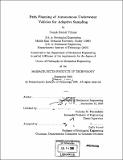| dc.contributor.advisor | Nicholas M. Patrikalakis. | en_US |
| dc.contributor.author | Yilmaz, Namik Kemal, 1975- | en_US |
| dc.contributor.other | Massachusetts Institute of Technology. Dept. of Mechanical Engineering. | en_US |
| dc.date.accessioned | 2008-02-28T16:26:55Z | |
| dc.date.available | 2008-02-28T16:26:55Z | |
| dc.date.copyright | 2005 | en_US |
| dc.date.issued | 2006 | en_US |
| dc.identifier.uri | http://hdl.handle.net/1721.1/35618 | |
| dc.description | Thesis (Ph. D.)--Massachusetts Institute of Technology, Dept. of Mechanical Engineering, February 2006. | en_US |
| dc.description | Includes bibliographical references (p. 235-244). | en_US |
| dc.description.abstract | This thesis develops new methods for path planning of Autonomous Underwater Vehicles for adaptive sampling. The problem is approached in an optimization framework and two methods are developed to solve it based on Mixed Integer Programming (MIP). The first method is predicated on network-flow ideas and is shown to have similarities to the Selective Traveling Salesman Problem. An important classification of the set of path-planning problems to be solved is the number of days that are involved in the complete sampling mission. Intrinsic limitations of the first network-flow-based method limit it to single day adaptive sampling missions. The second method emerged by taking into consideration the limitations of the first method and is based on a general MIP formulation. It is a more powerful formulation as it can handle multiple-day adaptive sampling missions, it is scalable as it can address the multiple vehicle case with ease, and it is more easily extensible to cover unforeseen situations that might arise as adaptive sampling concepts and needs evolve. The second formulation also allowed solution of auxiliary problems, required to determine suitable initial conditions for the main method. The method is applied to various test problems including evaluation of performance issues. | en_US |
| dc.description.abstract | (cont.) A real-world problem is also solved by the second method taking two different approaches. The first approach (static approach) involves a three-day-long adaptive sampling mission using the uncertainty information available on the first day. The second approach (dynamic approach) involves updating of the uncertainty information for each day using data assimilation features of the Harvard Ocean Prediction System and the Error Subspace Statistical Estimation system. The dynamic method is illustrative of how path planning for adaptive sampling fits into modern dynamic data driven oceanography. The results from the dynamic approach show that the uncertainty of the forecast decreases and becomes confined to a smaller region, indicating the strength of the method. | en_US |
| dc.description.statementofresponsibility | by Namik Kemal Yilmaz. | en_US |
| dc.format.extent | 244 p. | en_US |
| dc.language.iso | eng | en_US |
| dc.publisher | Massachusetts Institute of Technology | en_US |
| dc.rights | M.I.T. theses are protected by copyright. They may be viewed from this source for any purpose, but reproduction or distribution in any format is prohibited without written permission. See provided URL for inquiries about permission. | en_US |
| dc.rights.uri | http://dspace.mit.edu/handle/1721.1/7582 | |
| dc.subject | Mechanical Engineering. | en_US |
| dc.title | Path planning of Autonomous Underwater Vehicles for adaptive sampling | en_US |
| dc.title.alternative | Path planning of AUVs for adaptive sampling | en_US |
| dc.type | Thesis | en_US |
| dc.description.degree | Ph.D. | en_US |
| dc.contributor.department | Massachusetts Institute of Technology. Department of Mechanical Engineering | en_US |
| dc.identifier.oclc | 75966134 | en_US |
